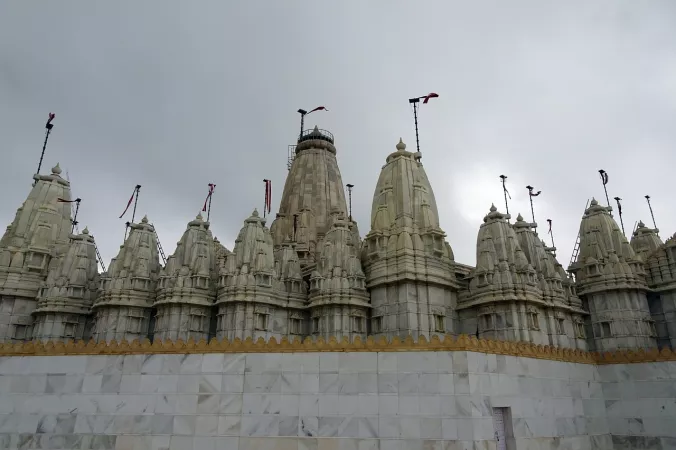Jain Temples Travel Guide
India is home to a rich cultural heritage, and the Jain Temples are a significant part of its history. The Jain Temples are known for their intricate architecture, stunning sculptures, and spiritual significance. Visitors flock to these temples to admire the craftsmanship and learn about Jainism, one of the oldest religions in the world. Jain Temples are famous for their peaceful ambiance and spiritual teachings that attract pilgrims and tourists alike.Top Attractions in Jain Temples
- Ranakpur Jain Temple
- Dilwara Temples
- Mount Abu Jain Temples
- Palitana Temples
- Shikharji
Jain Temples is Famous for
Spiritual significance and intricate architecture.Top Attractions in Jain Temples
- Admiring the intricate carvings at Ranakpur Jain Temple
- Exploring the marble beauty of Dilwara Temples
- Experiencing the tranquility at Mount Abu Jain Temples
- Climbing the 3,572 steps of Shikharji
What's Great about Travelling to Jain Temples?
- Experience spiritual enlightenment
- Admire stunning architecture
- Learn about Jainism and its teachings
What's Not So Great about Travelling to Jain Temples?
- May not appeal to those not interested in religious or historical sites
- Limited nightlife and entertainment options
- Strict dress code and rules to follow
Travel Tips for Jain Temples
- Respect the religious customs and traditions
- Wear modest clothing when visiting the temples
- Carry cash as some temples may not accept cards
Important Jain Temples trip information
- Ideal Duration: 2-3 days
- Best Time to Visit: October to March
- Nearby Airports and Railway Stations: The nearest airport is in Udaipur and the railway station is in Falna
FAQ's on Jain Temples
Q1: What is the best time to visit Jain Temples?
The best time to visit Jain Temples is during the winter months from November to February when the weather is pleasant and ideal for exploring the temples. This period avoids the scorching heat of summer and the heavy monsoon rains, ensuring a comfortable visit. Additionally, if you wish to witness any specific religious festivals or events at the temples, it's advisable to check the calendar for those dates.
Q2: Do I need a visa to travel to Jain Temples?
Visitors to Jain Temples do not require a specific visa to visit the temples as they are religious sites open to all. However, if you are traveling to the country where the temples are located, you may need a tourist visa depending on your nationality. It's recommended to check the visa requirements of the country you are traveling to for accurate information.
Q3: What are the must-visit attractions in Jain Temples?
The must-visit attractions in Jain Temples include the renowned [Name of Temple], [Name of Temple], and [Name of Temple]. Each temple is known for its intricate architecture, spiritual significance, and historical importance. Visitors should not miss exploring the [specific attraction] and experiencing the peaceful ambiance of the temples' surroundings.
Q4: Is Jain Temples a safe place to travel?
Jain Temples are generally safe for visitors. However, it's advisable to take standard precautions such as safeguarding your belongings, being aware of your surroundings, and following any guidelines provided by the temple authorities. Like any travel destination, it's recommended to stay vigilant and avoid isolated or unfamiliar areas, especially at night.
Q5: What is the local currency in Jain Temples and can I use credit cards?
The local currency in Jain Temples may vary depending on the country where the temples are located. It's recommended to carry local currency for small purchases at the temples and surrounding areas. While some larger establishments may accept credit cards, it's advisable to have cash on hand for convenience, especially in more traditional or rural areas.
Q6: What is the local cuisine like in Jain Temples?
The local cuisine around Jain Temples is often vegetarian, reflecting the principles of non-violence and compassion towards all living beings. Visitors can enjoy a variety of delicious dishes such as [specific dish], [specific dish], and [specific dish]. It's important to note that Jain cuisine typically excludes ingredients like onions, garlic, and certain root vegetables. Visitors with dietary preferences or restrictions will find plenty of options to savor.
Q7: What transportation options are available in Jain Temples?
Transportation options in Jain Temples may include public buses, taxis, auto-rickshaws, and rental services for convenient travel between the temples and nearby areas. Visitors can also explore the temples on foot to fully immerse themselves in the spiritual atmosphere and appreciate the architectural details. It's advisable to plan your transportation in advance, especially during peak tourist seasons, to ensure smooth travel experiences.
Q8: Are there any cultural norms or etiquette I should be aware of when visiting Jain Temples?
When visiting Jain Temples, it's important to respect the religious customs and traditions observed by the followers. Visitors are usually required to remove their shoes before entering the temples, dress modestly, and maintain a quiet and reverent demeanor within the sacred spaces. Photography may be restricted in certain areas, so it's advisable to seek permission before taking pictures. Additionally, it's recommended to greet locals with a polite "Namaste" and be mindful of any specific rules or guidelines provided by the temple authorities.
Q9: I am a travel agent. How can I buy travel leads of Jain Temples?
Register yourself as a travel agent at agents.tripclap.com and then you can buy travel leads to Jain Temples once your account is approved. For more details contact our support team at +91-8069186564 or support@tripclap.com

